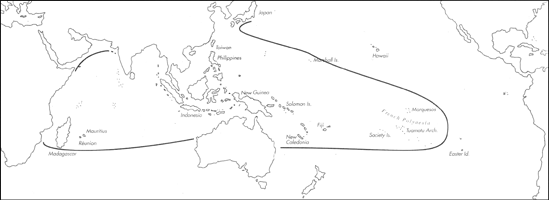
Skip Navigation Links
View access keys for this site.

Range: Indo-Pacific, except for Red Sea and Hawaiian Archipelago.
Description: Moderately large to large, solid to heavy. Last whorl conical; outline almost straight, sometimes convex below shoulder. Base moderately pointed. Shoulder sharply angulate. Spire low, outline usually sigmoid. Middle and late teleoconch sutural ramps concave, with 3 increasing to 4-6 spiral grooves; grooves often weak to obsolete. Last whorl almost smooth.
| Shell Morphometry | ||
|---|---|---|
| L | 60-170 mm | |
| RW | 0.67-2.42 g/mm | |
| (L 60-115 mm) | ||
| RD | 0.54-0.65 | |
| PMD | 0.85-0.94 | |
| RSH | 0.00-0.08 | |
Ground colour white. Last whorl usually encircled with 3 yellowish orange bands, at centre and within adapical and abapical thirds. Spiral rows of blackish brown, medium-sized, round to squarish spots, sometimes axially elongate or arrow- shaped, extend from base to shoulder. Base and siphonal fasciole bluish brown. Teleoconch sutural ramps with blackish brown oblique axial streaks. Aperture white, usually with a bluish brown basal edge. Periostracum brown to blackish brown, variably thick, translucent to opaque, and velvety to rough.
Dorsum of foot pink to reddish brown anteriorly, laterally and behind operculum, grey to beige with white radial lines on remaining portion; anterior edge with closely spaced black axial streaks; a dotted black pre-marginal line around entire median zone. Sole of foot solid reddish brown or grey mottled with pinkish cream to brown. Rostrum pink. Tentacles pink, tipped with white and dotted with grey. Siphon brownish red grading to rose distally or pink to violet, dotted with white, black and dark red (Pl. I, Fig. 18) (Bergh, 1895; Kohn, unpubl. observ.; Chaberman, pers. comm., 1981; Pearson, unpubl. observ.).
Habitat and Habits: Slightly subtidal to 50 m, juveniles sometimes dredged in 60 m. C. litteratus inhabits channels to large patches of fine or more often coarse sand, rubble and sand, silty rubble, sand with vegetation and even dense beds of sea- weed (Cernohorsky 1964, 1978; Kohn & Nybakken, 1975; Kohn, 1981; Tirard, pers. comm., 1989; Grosch, pers. comm., 1989). C. litteratus feeds exclusively on polychaetes, mainly Capitellidae, and serves as prey for C. marmoreus (Endean & Rudkin, 1965; Kohn & Nybakken, 1975; Kohn, 1980; Reichelt & Kohn, 1985). Egg capsules with a heavily corrugated surface and crenulated edges, affixed to the substratum by confluent basal plates. Egg diameter of 201-222 fm predicts a minimum pelagic period of 21-23 days (Perron & Kohn, 1985).
Discussion: C. litteratus appears to be closely related to C. leopardus, which often occurs sympatrically, sometimes in the same habitat. It may also resemble C. eburneus. For comparison, see the DISCUSSIONS of these species.

C. litteratus Range Map
This section contains verbatim reproductions of the accounts of 316 species of Conus from the Indo-Pacific region, from Manual of the Living Conidae, by Röckel, Korn and Kohn (1995). They are reproduced with the kind permission of the present publisher, Conchbooks.
All plates and figures referred to in the text are also in Röckel, Korn & Kohn, 1995. Manual of the Living Conidae Vol. 1: Indo-Pacific Region.
The range maps have been modified so that each species account has it own map, rather than one map that showed the ranges of several species in the original work. This was necessary because each species account is on a separate page on the website and not confined to the order of accounts in the book.
Return to framed version (returns to search page)